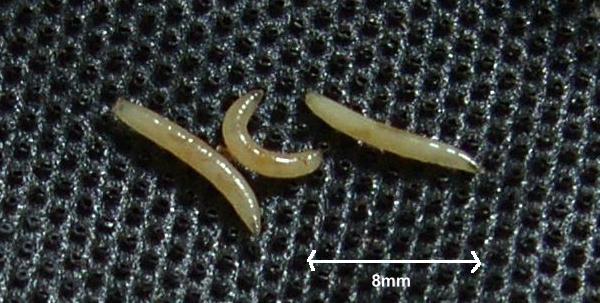
| HOME | SITEMAP | SEARCH | ARTICLES |
Scientific Name: Psila rosae
Other name: Carrot Rust Fly

The creamy-yellow larval stage of the Carrot Fly is very destructive to carrots, first burrowing around the outside, eventually tunnelling throughout the root. They are slender, without legs, and up to 1cm long. Parsnips, celery, dill, angelica and fennel can also be attacked. Ground-elder, hemlock and other umbelliferous plants such as Cow Parsley can act as alternative hosts. Affected plants show yellowing of the leaves, young plants can wilt and die, but usually recover and become stunted. It is frequently the cause of parsley failing to thrive, the seeds germinate, grow for a while then become yellow and spindly. The carrot root shows rust coloured tunnels around its circumference, not to be mistaken for cavity spot, a fungal disease causing elongated sunken spots on the surface. In parsnips the damage is usually near the crown and bases of the leaf stalks.
The rust-coloured tunnels can be seen in this affected parsnip which has also been infected by canker.The adult fly is about 8mm long with a shiny, blackish body similar to an ant with wings, the head is reddish-brown and the legs yellowish. They tend to appear periodically and are most prevalent when native umbellifers are in bloom, eg. Cow Parsley - there is an old practice of sowing carrots either before or after blooming occurs.
The female flies lay their eggs in the soil beside the host plants. These hatch about 7 days later depending on the temperature. The larvae move to the roots attacking the rootlets first. They develop through three growth stages over a 4 to 6 week period, then return to the soil to pupate for a further 2 to 4 weeks. Usually there are two generations per year, the first emerging in late April to early May and a second in late July. They overwinter as larvae in roots or as pupae in the soil, though a few adults may survive the winter.
They are low fliers rarely going above 50cm so one control is to surround vulnerable plants with a polythene barrier about 60cm high or to cover completely with garden fleece. Lifting the crop in autumn limits the damage. Sowing the seed very thinly to reduce thinning and removing any thinnings, limits the attack as they are attracted by the smell of the crushed plant. A technique called liquid sowing is a good method of obtaining a thin sowing. The seeds are suspended in Laponite gel and 'piped' like icing from the cut-off corner of a plastic bag. Delay sowing until May to avoid the emergance of the first generation. Avoid growing early and late crops together and if infestation occurs do not leave any roots in the ground to carry over to the next season.
Sowing at the correct time will avoid the flying insects. If sown in early June, the first generation females will have nowhere to lay their eggs so there should be fewer second generation flies to emerge. Other sowings in late autumn or early spring for harvesting in the summer should be at lower risk.
Harvesting before the second generation can do too much damage is important so lifting the June sown carrots by November should reduce their exposure to damage. Any left after this will be vulnerable and can provide overwintering quarters for the grubs.
As Cow Parsley is the natural host for the grubs, disturbing the carrots such as weeding or thinning, when this plant is in flower will invite the flying insects to the crop.A new biological control in the Nemasys range of products, is on the market to kill the root fly . It contains a number of nematode species and in addition is claimed to control Cabbage Root Fly, Caterpillars, Codling Moth, Cutworms, Gooseberry Sawfly, Leatherjackets, Onion Fly, Ants, Sciarid and Thrips. However one pack treats 60m2 and in order to catch all of the target species has to be applied every two weeks throughout the season so it would be expensive.
Companion planting or interplanting has also been tried the idea being to put the females off the scent using onions or garlic. This is not totally effective as the flies use other methods to locate, although spraying the crop with a concentrated garlic extract has been tried. Commercially a plant called medic (Medicago litoralis) a type of clover, has been tried. There are also resistant cultivars of carrot, eg. 'Fly-away'.
The genetic modifiers are developing chocolate flavoured carrots to entice childern, maybe the carrot flies won't like chocolate!Chemical control is not really effective as the ones used in the past have been withdrawn.
Back to GARDEN CREATURES